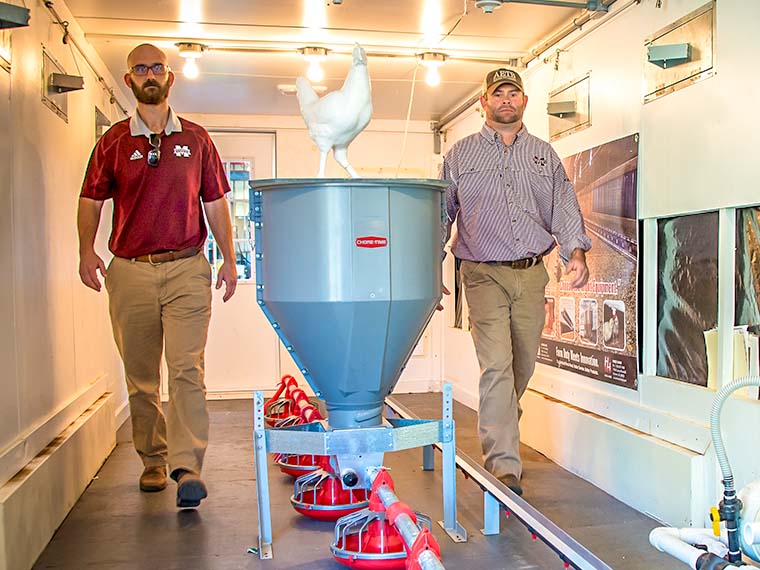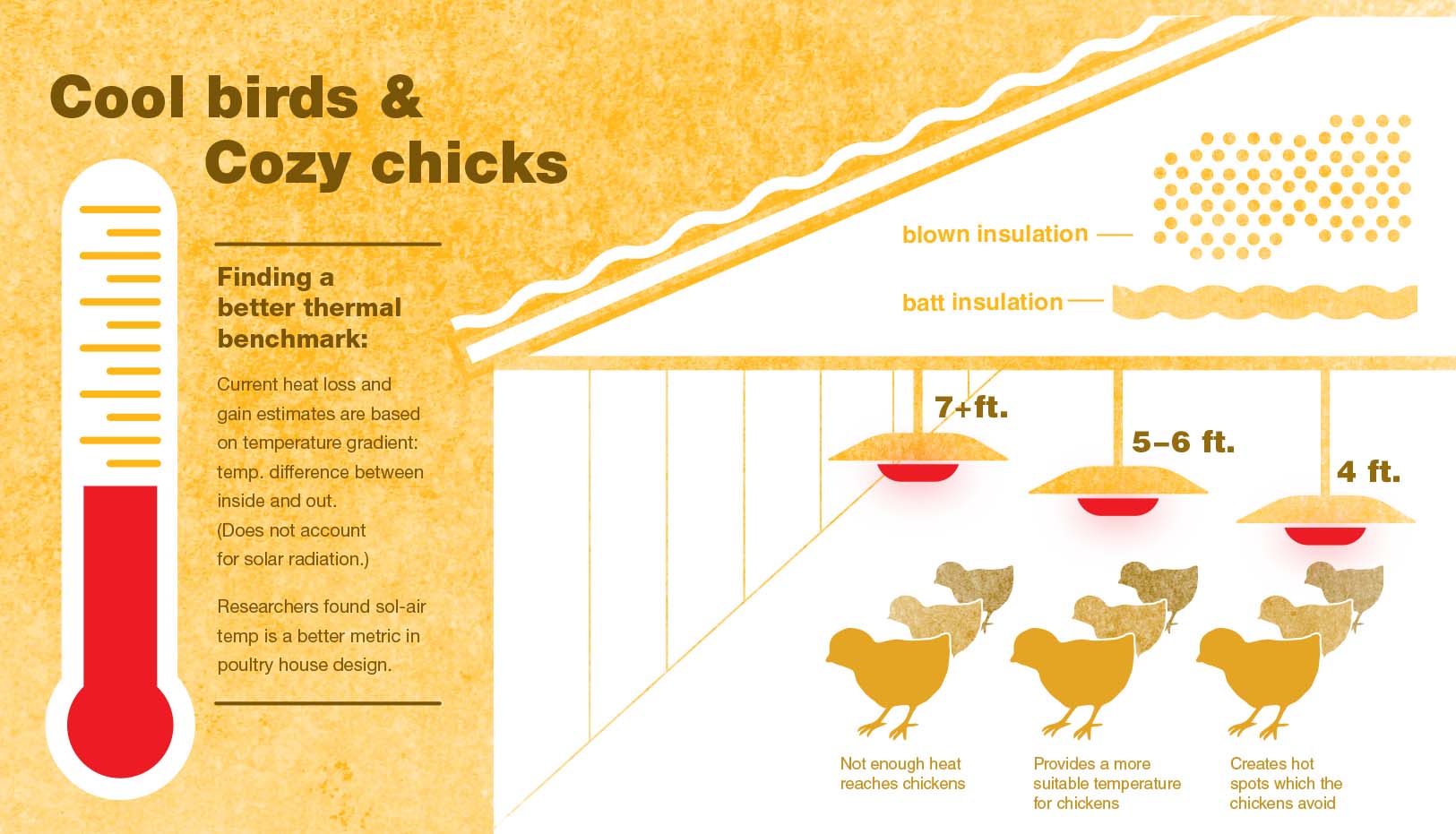The information presented on this page may be dated. It may refer to situations which have changed or people who are no longer affiliated with the university. It is archived as part of Mississippi State University's history.
Poultry is big business in Mississippi. In 2016, the state's broiler production value totaled $2.23 billion dollars. A researcher in the Mississippi Agricultural and Forestry Experiment Station and an engineering specialist in the MSU Extension Service are studying ways to optimize energy efficiency in poultry houses to reduce producer inputs and increase their bottom lines.
Energy expenditures account for about 60 percent of the input costs for the state's nearly 1,500 poultry producers. Heating fuel alone can hover in the 40 percent range. Dr. Daniel Chesser, research associate III, studied energy transfer in poultry houses while Dr. John Linhoss, extension associate III, studied heaters and lighting. Both are in the Department of Agricultural and Biological Engineering in the College of Agriculture and Life Sciences. Each focused on ways to reduce producer inputs and increase efficiencies of the housing envelope across the life of a facility.
Hot weather, cool birds
Oftentimes, thermal insulation is thought of as a way to protect from the cold. That's only half the story though. Keeping chickens cool during Mississippi's long, languid summers is just as critical to the animal's health and welfare and the grower's production efficiency.
Chesser studied heat conduction and thermal resistance in commercial poultry houses. Heat conduction is the movement of heat into or out of the house while thermal resistance has to do with a house's ability to keep out the heat in hot months and keep in the heat in cold months. Chesser's team evaluated ceiling insulation and temperature grades across cold and warm seasons.
"We were trying to characterize what was happening in the house in terms of heat loss during cold conditions and heat gain in warm conditions," Chesser explained. "During cold weather, the producer fights to keep the birds warm especially in the early stages of production during the brooding phase. In the summertime, the producer fights to keep the birds cool especially in the later stage of production due to heat produced from the birds and radiant heat that enters the building from the sun. We need to look for ways to reduce the transmission of heat entering or leaving the structure in order to more efficiently produce a thermally-comfortable environment for the flock year-round."
The research included three separate studies. In the first two studies, the team measured and compared heat conduction in a new and old house, and then characterized the thermal resistance in each house.
"The major result we got from these two studies was that insulation shifting in the older house was problematic and led to reduced thermal resistance," Chesser explained. "However, this shifting can be detected through regular inspections. If a producer sees the shifting occur, he or she can have more insulation blown in to protect the thermal resistance of the house."
In the third study, the researchers assessed the design temperatures used for estimating heat loss and gains for specifying energy requirements and insulation needs.
"Typically, building thermal insulation is designed to withstand cold weather conditions, but insulation serves two purposes. It keeps the heat in during cold conditions but also keeps the heat out during warm conditions," Chesser explained. "Most broiler houses are clad with corrugated metal roof and siding. Radiant heat from the sun can exacerbate rate of heat gain into the building, especially for a metal clad structure during warm conditions, by increasing the temperature of exterior building surfaces beyond that of outdoor air temperatures."
Traditionally, heat loss and gain estimates for poultry house design are based on temperature gradient, the difference in ambient air temperature between inside and outside conditions. However, this method does not account for the effects of solar radiation from the sun during warm conditions. Sol-air temperature is a proxy temperature that can be calculated and used in place of ambient air temperature to better account for the effects of solar radiant heat exchange.
Chesser's team monitored and evaluated outside ambient air temperature, outside surface temperature, and sol-air temperature to determine if there was a better thermal benchmark to consider when estimating heat loss and gain for specifying poultry house energy and insulation requirements.
Chesser said the team wanted to assess the ambient air temperature currently used in estimating insulation requirements and heat load in design and compare that temperature to surface and sol-air temperatures to see how each would affect the team's estimations for energy transfer within the house.
The team determined that sol-air temperature was a better estimator of temperature gradient in the calculation and estimation of insulation requirements.
Chesser said all three studies will help aid in best management and design practices that will help integrators and producers alike find ways to optimize the housing envelope of commercial poultry facilities.
"Our purpose here, especially as a land-grant university, is to provide information to the industry and our producers that will make them more efficient and profitable while making their flocks more comfortable," Chesser said. "That's what is really rewarding about the research."
Radiant heat, cozy chicks
While radiant heaters are the most commonly used type of heater in commercial broiler houses, there really isn't a standardized metric to measure their efficiency. John Linhoss and his team set out to find a way to establish that metric and determine exactly how much radiant heat was reaching brooding chicks at the floor level. Linhoss said the research is relevant to producers because so much of a grower's costs are tied up in heating and fuel.
"Heating fuel and electricity costs can account for as much as 60 percent of the variable cost for growers," Linhoss said. "Growers can use anywhere from 3,000 to 5,000 gallons of propane per house per year. At $1.50 a gallon, that can add up to around $4,500–$7,500 in annual fuel costs on a single house. Combine that with the fact that the average grower has between four and eight houses and the costs can add up quickly."
Radiant heat beams down and is absorbed by whatever is in its path. While all of us are familiar with radiant heat, which Linhoss describes as what you feel when you are standing next to a campfire, people are less familiar with the idea of radiant heat used to heat buildings.
"Most homes use forced air heating," Linhoss explained. "That type of heating would be inefficient in a poultry house setting, which is why commercial growers use radiant heaters."
A source of warmth is particularly critical during the brooding period, the first seven to 10 days of a chick's life, when the chicks are unable to self-regulate their temperature. When chicks are placed into a house, air temperatures are usually around 85-90°F. Target air temperatures are reduced every couple of days until a temperature of around 70°F is reached and maintained for the remainder of the growout.
While previous research used infrared thermography to measure litter temperature, Linhoss's team measured radiant flux, which can be used to determine amount of radiant heat actually hitting the floor. The research focused on measuring the efficiency for six types of round radiant heaters, capable of emitting 40,000 Btu per hour each. The heaters were placed at varying height levels.
"We formulated a performance metric by measuring the amount of energy hitting the floor, instead of just temperature," Linhoss said. "Our goal was to see if the heat being generated in the house ended up where it ultimately needed to go."
The research found that a large amount of the energy never reached the chicks. In fact, a maximum of 41 percent of available energy made its way to the floor. Linhoss said the height of the heaters played a role.
"Each time you bring equipment into the house, you have to raise the heaters. Sometimes they don't get returned to the correct height," Linhoss explained. "We found heater height greatly impacted heat distribution. When the heaters are placed too high, not enough heat can reach the chicks. When they are placed too low, hot spots, or areas where the chicks avoid, are created. In both instances, incorrect height placement can result in energy wasted."
Linhoss is using the results of this particular study to establish recommendations for heater manufacturers and growers. Other research Linhoss is involved in includes evaluating radiant flux preferences of chicks during the brooding period.
"This research will help us better understand how chicks interact with the thermal environment, which could help identify areas where changes can be made to improve production efficiency," Linhoss said.
In his latest project, he is studying light intensities in poultry houses.
"One of the issues growers face in Mississippi is keeping birds cool in the summertime," Linhoss said. "As houses get larger, more fans are brought in to cool the birds. More fans mean more ambient light. Since light control is critical in the growth cycle of the chickens, we are trying to determine what the light intensity levels are at the floor level."
Whether it's studying heating or lighting, Linhoss is focused on helping develop best practices to maximize potential energy efficiency throughout the house. And potential benefits for producers drive the research.
"The purpose of all our research is to help the growers in Mississippi," Linhoss said. "We are trying to help them save money because the less energy they use, the more money they make. It really helps the profitability of the industry, but more specifically individual growers."


